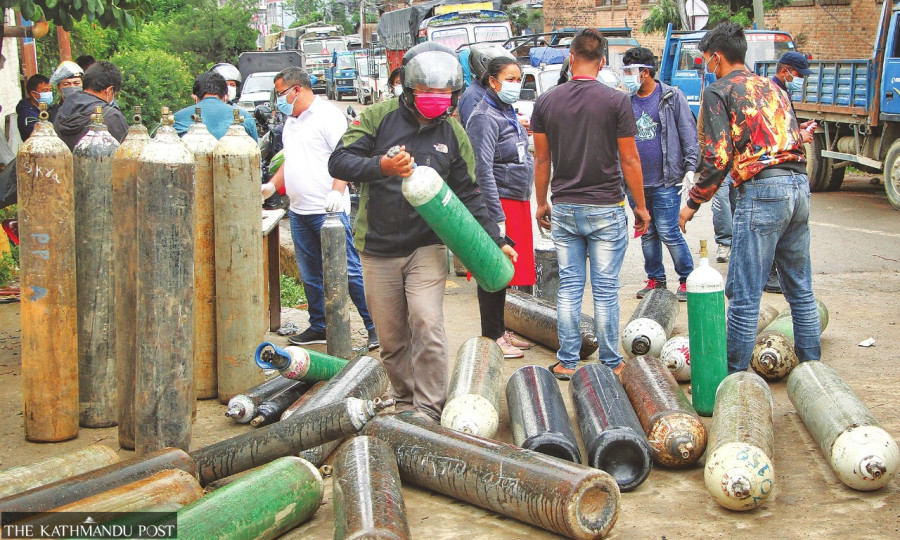National
Oxygen underestimation led to scourge of second wave, report says
The government failed to supply oxygen cylinders to hospitals as per need assessment it made with World Health Organisation long before the second wave of the pandemic struck.
Prithvi Man Shrestha
The second wave of the Covid-19 pandemic came as a hurricane in April last year as it defied the government projection regarding the need for oxygen affecting its preparations for the impending crisis, a special audit report has found.
The government had projected 60,035 critical cases and half the number of complicated Covid-19 cases from mid-April to mid-July when the second wave of pandemic hit the country.
Based on this estimate, the government had projected the need for 3.85 million tonnes of oxygen, equivalent to 566,661 cylinders, for three months. But the second wave was so dangerous that the country witnessed critical and mid-level complicated cases six times the projected figures, leading to an acute shortage of oxygen.
There were 381,587 people infected with Covid-19 who required oxygen in three months, according to the report of the Office of Auditor General released on Wednesday. “The Health Ministry failed to estimate the spread of the Covid-19 properly and to manage oxygen accordingly in short-term and long-term,” the report states.
Long before the second wave hit the country, the ministry and the World Health Organisation had assessed the need for oxygen at 89 hospitals of the seven provinces and published ‘Provincial Profile’. As per the report, there was the need for 9,798 oxygen cylinders in those hospitals. But only 5,205 cylinders of oxygen were available.
“Except for seven hospitals of Lumbini province, oxygen was not adequately available in hospitals of the other six provinces,” states the report. “As a result, Covid-19 patients admitted to these hospitals failed to get oxygen as required.”
Dr Baburam Marasini, former director at the Epidemiology and Disease Control Division, said that the government failing to manage oxygen as per the study suggests that it underestimated the impending Covid-19 crisis and failed to make necessary preparations. “The recommendation of the study means there had been evidence-based recommendation and it was not followed,” he said.
Hospitals were turning away new patients due to the shortage of oxygen. As a result, many patients faced untimely deaths.
Gaurav Sharda, president of Nepal Oxygen Industries’ Association, says that the country faced shortage of oxygen due to lack of timely action.
“Only after people started to die in India due to shortage of oxygen, did the government invite us to talk about how we can supply oxygen,” said Sharda, who is also director of Kantipur Oxygen Pvt Ltd. “The government did not consult with us about the supply situation of oxygen even though experts had been warning about the second wave long ago.”
As the number of cases and death counts soared, social media was full of appeals of people asking for the supply of oxygen for their relatives. Large number of people crowded around the compounds of oxygen bottling plants. “Relatives of patients used to wait for hours outside our factory’s compounds, hoping to get a cylinder of oxygen,” Sharda recollected. “Oxygen plants were operating 24 hours a day. If a day had 30 hours, it would not be enough to produce required oxygen.”
Amid surging demand for oxygen, questions were raised about uneven distribution of oxygen cylinders in hospitals. The Covid-19 Crisis Management Centre (CCMC) on May 10 last year introduced a quota system to address the situation.
As the quota system was introduced without study about the flow of patients in each hospital, the move backfired. The hospitals failed to get required oxygen, forcing the CCMC to scrap the quota system in just four days after its implementation, according to the report.
The same week the quota system was introduced, a total of 1,281 people died due to Covid-19, the report says. “There is the need for a study of why the number of deaths soared at the same time when the quota on oxygen supply was introduced.”
According to Sharda, when there was an acute shortage of oxygen in Kathmandu Valley and Lumbini Province, the capacity of oxygen plants in eastern Nepal remained underused. “This also suggests the lack of proper planning to ensure supply of oxygen from eastern Nepal to the areas facing shortage,” he said.
The government also failed to make timely procurement of oxygen cylinders and relied heavily on donated oxygen cylinders and oxygen plants. During the second wave of pandemic, as many as 8,937 people died, compared to 3,014 deaths during the first wave in 2020, according to the auditor general’s report.
Besides the government’s inadequate preparations to manage oxygen for the second wave, the report has also pointed out other anomalies. By mid-July 2021, there were 96 labs, including 38 private labs, conducting Covid-19 tests. As many as 49 or 51 percent of total labs were concentrated in Bagmati Province. Even within the Bagmati province, 69 percent labs were concentrated in three districts—Kathmandu, Bhaktapur and Lalitpur.
The report has also pointed out other irregularities such as overpayment for the procurement of medical kits. While buying 155,000 antigen kits through the United Nations Children Fund (UNICEF) on April 15, 2021, Rs3.2 million was paid as contingency buffer without any grounds. The auditor general’s report has recommended taking back the paid money.
Likewise, while buying 500,000 antigen kits on June 30, 2021 through UNICEF, the government made an overpayment of Rs11.54 million which must be returned, the report says.
The report has also pointed out a massive discrepancy in the cost of dead body management, shouldered by the Nepal Army. The Valley Command (pritna) Headquarters of Nepal Army spent Rs5,558 per dead body while Far-West Command, Kailali spent as high as Rs58,261 per dead body, the report states.




 15.24°C Kathmandu
15.24°C Kathmandu








%20(1).jpg&w=300&height=200)





